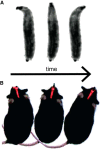Algorithms for Olfactory Search across Species
- PMID: 30381430
- PMCID: PMC6209839
- DOI: 10.1523/JNEUROSCI.1668-18.2018
Algorithms for Olfactory Search across Species
Abstract
Localizing the sources of stimuli is essential. Most organisms cannot eat, mate, or escape without knowing where the relevant stimuli originate. For many, if not most, animals, olfaction plays an essential role in search. While microorganismal chemotaxis is relatively well understood, in larger animals the algorithms and mechanisms of olfactory search remain mysterious. In this symposium, we will present recent advances in our understanding of olfactory search in flies and rodents. Despite their different sizes and behaviors, both species must solve similar problems, including meeting the challenges of turbulent airflow, sampling the environment to optimize olfactory information, and incorporating odor information into broader navigational systems.
Keywords: active sensing; memory; olfaction; olfactory navigation; olfactory search; turbulence.
Copyright © 2018 the authors 0270-6474/18/389383-07$15.00/0.
Figures




References
-
- Baker TC. (1990) Upwind flight and casting flight: complementary phasic and tonic systems used for location of sex pheromone sources by male moth. In Proceedings of the 10th International Symposium on Olfaction and Taste (Døving ED, ed), pp 18–25. Oslo: Graphic Communication System.
